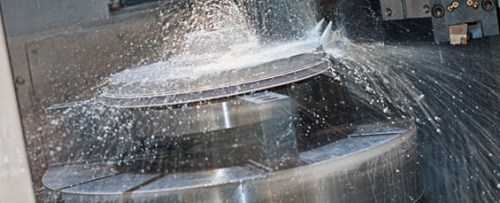The Case for VTLs
Post Date: 12 Jun 2014 Viewed: 307
�In 2-axis turning, the majority of manufactured parts tend to stay well under 12” in diameter and under 100 lbs. However, this is the majority, not the entirety. There are those brave souls who take it upon themselves to push a machine's limits and squeeze out the largest parts a work envelope can safely handle (and generally beyond) just to make a living. Large parts, however, present a myriad of problems in traditional horizontal lathes. This is where a vertical turning lathe (VTL) can be an underutilized and often misunderstood piece of equipment. The purpose here is to help understand the strengths of a VTL and dispel some of the myths and concerns that these machines inspire.
VTL Strengths
With regards to strengths, some are pretty obvious, while others are less so. For example, an obvious strength is the ability to load larger parts into the spindle and let gravity work in your favor instead of against you. All too often large part manufacturing sounds closer to the jack hammering of concrete due to the amount of beating required to get the part held tight in the chuck and against any backstops. In a vertical lathe, we can credit Sir Isaac Newton for a bit of help and as long as the chuck and jaws are clean, the part is fully seated and the spindle is up and turning again. "Gravity loading" means that heavy parts rest upon the stops prior to clamping. Using gravity to assist with part loading eases work with hard-to-clamp, non-uniform shaped parts and reduces reliance upon custom toolholding. The same part requires less clamping pressure in a vertical lathe, therefore improving accuracy, especially in thin-walled parts.
Vertical turning also significantly reduces spindle sag and the need for over-engineered and costly-to-replace spindles. The machine’s cutting power is maximized due to the absorbtion of downward cutting forces by the base and foundation. Benefits of added spindle rigidity include capability to work with heavier parts and difficult-to-machine materials; higher accuracy; improved surface finish, and notable reductions in cutting tool wear and breakage.
Another overlooked benefit of a VTL is the overall machine footprint can be considerably less than that of a comparable horizontal lathe by approximately 50%. Now if your shop skyline is getting a bit crowded, that can be an issue. But typically large-part manufacturing requires large spaces and headroom is traditionally less expensive than floor space. Combine the ability to fit an 18” chuck, 40hp spindle and 1.25” stick tooling in a lathe that only takes up 7x10ft2 on your floor, and that’s one awfully powerful tool! Throw in the addition of a door that allows easy access to the part along with a hoist and you have a best-case scenario with a VTL to handle oversized parts.
VTL Myths
And then there are the VTL myths. One that comes up the most often is that a VTL is difficult to program because the axes are aiming somewhere different than what one expects in a typical horizontal lathe. If you program the machine exactly like you would a horizontal, you will never notice the difference.
After introducing a few first-time users who were very concerned about the VTL programming aspect to the setup and helping them through their initial training, their earlier fears have now become laughing points when we see each other. You know, those ‘You remember when…? I can’t believe we were worried about that…’ moments?
Another concern that I have heard on multiple occasions is that if they run out all their large parts, what are they going to do with this machine? The truth is that it doesn’t have to be a large part to be turned on a VTL! While these machines are traditionally used for the manufacture of valves, rings, and other large parts 30" in diameter or larger, a VTL is a cost-effective solution for the manufacture of parts as small as 6" in diameter. Though they lend themselves well to large parts, and smaller parts do look a bit odd in a machine with the capacity the VTL’s typically have, there is no reason you cannot put an 8” part in an 18” chuck. Though you won’t have the 5000rpm the Okuma LB series has, it will still work just fine.
The last myth, off the top of my head, is that a VTL is terrible for chips. While it is true that chips may sit on top of the chuck and need blown off after a cycle, the design of the casting around the spindle is such so all the chips flow into the chip conveyor in the most efficient way possible. All of the flood coolant lines that can be easily routed will generally take care of anything that gravity does not.
So, with a few large parts in mind, does a VTL fit your process? Probably. The higher upfront costs of a VTL as compared to a horizontal lathe is often offset by the substantial long-term savings.




